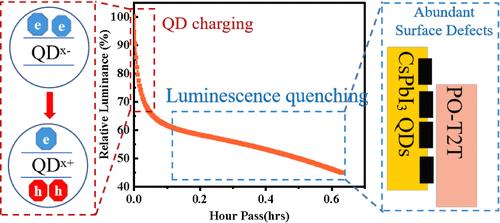当前位置:
X-MOL 学术
›
ACS Photonics
›
论文详情
Our official English website, www.x-mol.net, welcomes your feedback! (Note: you will need to create a separate account there.)
Mitigating Perovskite Light-Emitting Diode Degradation Mechanisms through Forward Electrical Pulses
ACS Photonics ( IF 6.5 ) Pub Date : 2024-05-29 , DOI: 10.1021/acsphotonics.4c00220 Ming Deng 1, 2, 3, 4 , Yanming Li 2, 3, 4 , Xuanyu Zhang 2, 3, 4, 5 , Chunyan Wu 2, 3, 4 , Shuo Ding 2, 3, 4, 5 , Ting Zhang 2, 3, 4 , Mi Zhou 6 , Ruifeng Li 2, 3, 4 , Chaoyu Xiang 1, 2, 3, 4
ACS Photonics ( IF 6.5 ) Pub Date : 2024-05-29 , DOI: 10.1021/acsphotonics.4c00220 Ming Deng 1, 2, 3, 4 , Yanming Li 2, 3, 4 , Xuanyu Zhang 2, 3, 4, 5 , Chunyan Wu 2, 3, 4 , Shuo Ding 2, 3, 4, 5 , Ting Zhang 2, 3, 4 , Mi Zhou 6 , Ruifeng Li 2, 3, 4 , Chaoyu Xiang 1, 2, 3, 4
Affiliation

|
The lifetime testing curve of perovskite quantum dot light-emitting diodes (Pe-QLEDs) reflects the complex interaction of various factors, including the inherent quantum dot (QD) leading to rapid decay and carrier injection imbalance issues. Mitigating these factors and understanding charge dynamics are crucial to enhance the stability and EQE of Pe-QLED devices. In this study, we first established a capacitance–voltage (C–V) model for Pe-QLEDs. We then analyzed the charge dynamics characteristics of four different regions in the typical C–V model, including the dark current region, low injection region, recombination region, and charge accumulation region. We revealed the quenching at the interface between CsPbI3 QD and PO-T2T, as well as the injection imbalance issue. To address these issues, we designed a TmPyPB buffer layer with a shallow LUMO level at the interface between CsPbI3 QD and PO-T2T to mitigate the defect increase caused by PO-T2T and enhance electron injection, thereby promoting charge balance. The C–V characteristic curves of the optimized Pe-QLED with the buffer layer confirmed the reduction of defects and the enhancement of radiative recombination. The optimized Pe-QLED exhibited a significant improvement in external quantum efficiency (EQE) from 11.66% to 19.57%. It demonstrated stable operation for T57 = 1.56 h at 1000 nit after forward electrical pulses. Through C–V modeling and Nyquist plots, we quantitatively understood the charge dynamics processes in Pe-QLEDs, which provide clear directions for improving Pe-QLED EQE and stability.
中文翻译:

通过正向电脉冲减轻钙钛矿发光二极管的退化机制
钙钛矿量子点发光二极管(Pe-QLED)的寿命测试曲线反映了各种因素的复杂相互作用,包括固有的量子点(QD)导致快速衰减和载流子注入不平衡问题。缓解这些因素并了解电荷动态对于提高 Pe-QLED 器件的稳定性和 EQE 至关重要。在这项研究中,我们首先建立了 Pe-QLED 的电容电压 (C-V) 模型。然后,我们分析了典型 C-V 模型中四个不同区域的电荷动力学特性,包括暗电流区、低注入区、复合区和电荷积累区。我们揭示了 CsPbI 3 QD 和 PO-T2T 界面处的猝灭以及注入不平衡问题。为了解决这些问题,我们在CsPbI 3 QD和PO-T2T之间的界面设计了具有浅LUMO能级的TmPyPB缓冲层,以减轻PO-T2T引起的缺陷增加并增强电子注入,从而促进电荷平衡。带缓冲层的优化 Pe-QLED 的 C-V 特性曲线证实了缺陷的减少和辐射复合的增强。优化后的 Pe-QLED 的外量子效率 (EQE) 从 11.66% 显着提高至 19.57%。在正向电脉冲后,它在 1000 尼特的 T 57 = 1.56 小时内表现出稳定运行。通过 C-V 建模和奈奎斯特图,我们定量地了解了 Pe-QLED 中的电荷动力学过程,这为提高 Pe-QLED EQE 和稳定性提供了明确的方向。
更新日期:2024-05-29
中文翻译:

通过正向电脉冲减轻钙钛矿发光二极管的退化机制
钙钛矿量子点发光二极管(Pe-QLED)的寿命测试曲线反映了各种因素的复杂相互作用,包括固有的量子点(QD)导致快速衰减和载流子注入不平衡问题。缓解这些因素并了解电荷动态对于提高 Pe-QLED 器件的稳定性和 EQE 至关重要。在这项研究中,我们首先建立了 Pe-QLED 的电容电压 (C-V) 模型。然后,我们分析了典型 C-V 模型中四个不同区域的电荷动力学特性,包括暗电流区、低注入区、复合区和电荷积累区。我们揭示了 CsPbI 3 QD 和 PO-T2T 界面处的猝灭以及注入不平衡问题。为了解决这些问题,我们在CsPbI 3 QD和PO-T2T之间的界面设计了具有浅LUMO能级的TmPyPB缓冲层,以减轻PO-T2T引起的缺陷增加并增强电子注入,从而促进电荷平衡。带缓冲层的优化 Pe-QLED 的 C-V 特性曲线证实了缺陷的减少和辐射复合的增强。优化后的 Pe-QLED 的外量子效率 (EQE) 从 11.66% 显着提高至 19.57%。在正向电脉冲后,它在 1000 尼特的 T 57 = 1.56 小时内表现出稳定运行。通过 C-V 建模和奈奎斯特图,我们定量地了解了 Pe-QLED 中的电荷动力学过程,这为提高 Pe-QLED EQE 和稳定性提供了明确的方向。






































 京公网安备 11010802027423号
京公网安备 11010802027423号